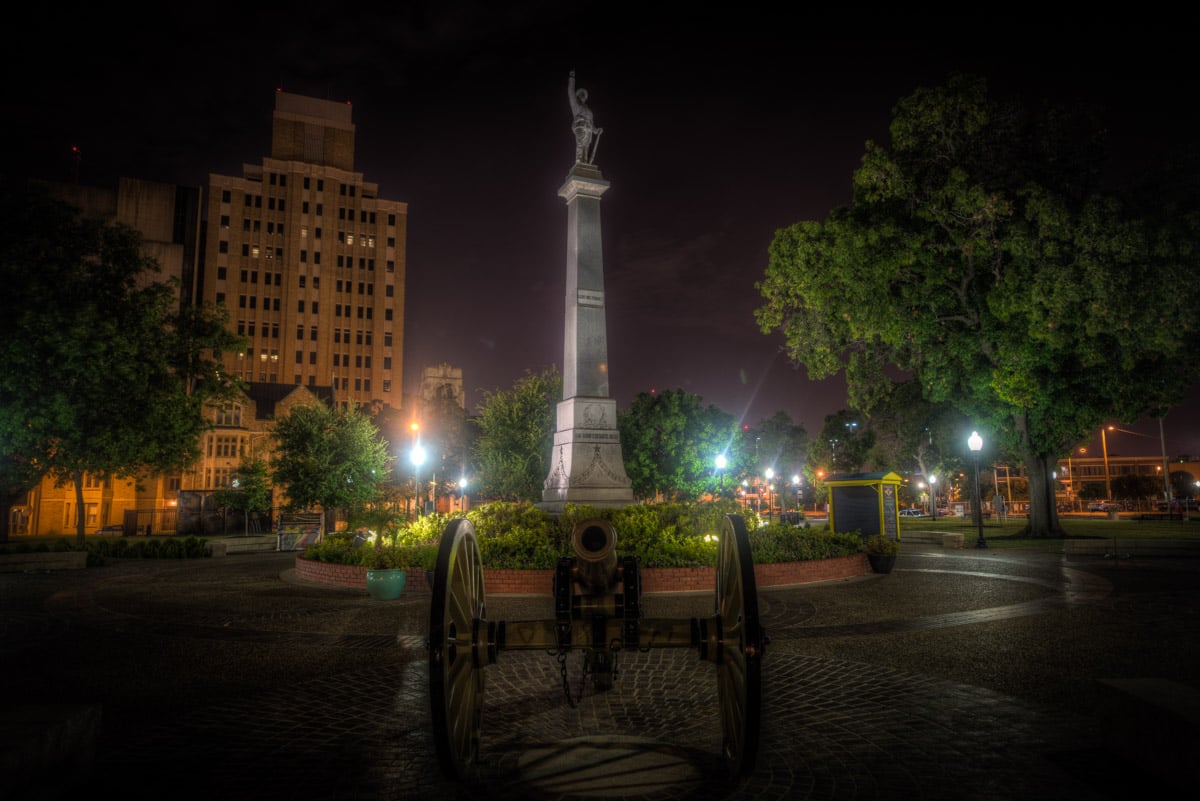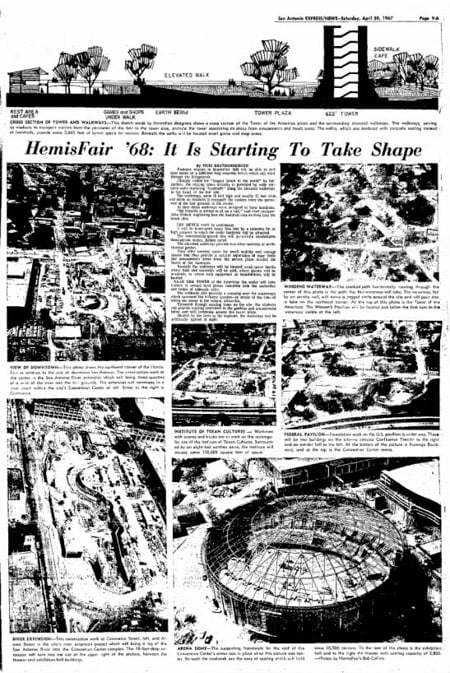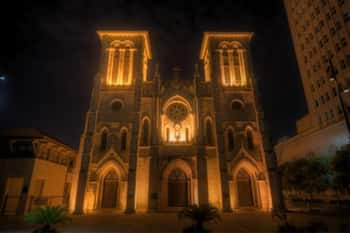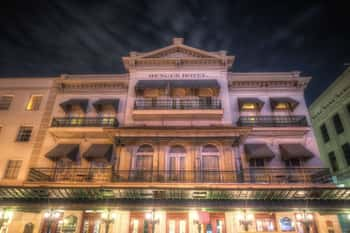
Ben Stiller. A Night At the Museum. Like it or hate it, Ben Stiller’s blockbuster hit about artifacts coming to life in the dead of night played to all the child-like awe that lives inside us, even as adults. Granted, they also had to fight a lot of bad guys—three movies’ worth of bad guys—but fact is: A Night at the Museum did so well, particularly because there is always the thought of, what if?
What if immovable objects morph into animated objects as soon as the lights go off at the museum?
What if there is entire world happening at a museum as soon as the employees head home for the night?
San Antonio, Texas’ Institute of Texan Cultures should have been the textbook copy for any movie about haunted museums. Apparitions? Check. Weird paranormal phenomena? Double check. Disembodied voices? Check, check, check.
The online source, Creepy Basement, titled its article about the institute, “Something spooky is going on inside of this Texas Museum.” This title was only followed by the sub-title (which I love even more): “This museum has a ghost infestation problem."
What sort of ghost infestation problem? Take a seat, click off Ben Stiller running from a dinosaur in A Night at the Museum and let me tell you about the real thing.
San Antonio, Texas, is a strange hodgepodge of old and new, Colonial Spanish and clean-lines modern. Unfortunately, it was at the start of the twentieth century when a lot of historic properties came face to face with a bulldozer. Unlike in Savannah, where the historic preservation societies started earl(ier) by literally plopping eighteenth-century houses on top of trailers and moving them to different parts of the city, San Antonio’s government didn’t react quite in the same manner.
A house in the way? Tear it down.
A whole section in the way? Move a few homes and demolish the rest.
Even the Old Spanish Governor’s Palace (which was never actually a governor’s palace) almost was sliced to pieces before being saved (and recognized) in the early 1930s.
But San Antonio’s city landscape didn’t face quite the axe until 1968 and the HemisFair Fair.

And so the HemisFair construction begins! The Institute of Texan Cultures was one of many new buildings for the World's Fair. (Source: Express and News)
Think of the geographical mutilation that the Olympics village can wreak on cities and you’ve got the HemisFair, better known as the World’s Fair or the International Exposition. For the most part, cities where the World’s Fair has been held have spent extraordinary amounts of money on setting the “scene” only to have it all go to waste once the event has closed its curtains.
In 1968, the World’s Fair was held in San Antonio, Texas, where the theme was: “The Confluence of Civilizations in the Americas.” (This was to also commemorate the 250th anniversary of San Antonio’s founding in 1718).
The theme is ironic, mainly because after searching San Antonio for the perfect “spot,” Governor John Connelly, along with then-President and Texan Lyndon B. Johnson, decided on the best spot.
Only, the best spot was also a neighborhood. More specifically, a neighborhood whose demographics teetered greatly in the “minority” or “low-rent housing” scale. No matter, the Governor and President must have thought, we’ll just get them to move and we’ll build a great institute that commemorates all ethnicities.
Making America great again, the 1968 version.
Most of the families in the area were Chinese, African-American and Irish, and most went bankrupt after being displaced from their homes and given little money as reparation for being shoved out of their homes.
Allegedly, there was only one (I’m sure there were more, but just did not reach as much acclaim to fame) success story from the HemisFair displacement, and that was the gentleman who started and founded Church’s Fried Chicken.
George W. Church was a man known for cooking up some of the best fried chicken the neighborhood had ever known—but when the government decided to go after his slice of home, Church was forced to move to a separate section of town. That section just so happened to be directly across from the Alamo, and Church’s Fried Chicken, as they say, was hatched.
Church’s chicken proved to be the most popular chicken in San Antonio and saw great success—and considering that it is now a nationwide chain, it’s safe to say that George W. Church made the most out of being displaced from his home and business and started anew elsewhere.
Unfortunately, success stories like Church’s weren’t a dime a dozen during this unstable period, and for the most part these families were met with no help whatsoever. Perhaps one of the only reasons that what is left of that part of San Antonio still stands, is due to the fact there was quite a number of politicians who disagreed with the deconstruction.
La Villita, one of San Antonio’s most prized historic neighborhoods, was saved as a result of their support and determination to see San Antonio’s prized landmarks survive another generation.
First hailed as the “Texas Pavilion,” 1967 saw the beginning of the tall, spindly tower’s construction. It finished less than a year later in 1968, just making the cut for HemisFair. Right after, it was promptly transformed into a permanent museum showcasing the various cultures of South Texas.
(Ironic, right?)
Within just three years, in 1971, the Institute of Texan Cultures was a fully fledged museum. Its executive director was R. Henderson Shuffler, who actually lived in an apartment on site, which really gives meaning to the saying, “bring work home."
Since the 1970s, the institute has become one of the most popular tourist attractions in all of San Antonio. (We’ve even had guests call us to ask about it, which led to us writing this article!)
For the last two decades or so, the museum has also added Naturalization Ceremonies to its repertoire, allowing resident aliens to finally become citizens of good ole Uncle Sam. These events are usually held just once a month, but continue to bring out loads of people to bear witness to them. As a recent affiliation of the Smithsonian Institution, the Institute of Texan Cultures has offered exhibits like “Our Part of Victory,” which discussed Texas’ part in World War II, as well as “Converging Texan Cultures,” which brought together media archives on Texas architecture, food and clothing.
Rhett Rushing, a folklorist at the museum, once told the online newspaper, mySA, that “San Antonio [is not only] predisposed to ghost stories because of its cultural history, but the large mix of cultures over hundreds of years makes this a ghost lover’s paradise."
And at the epicenter of it all is the Institute of Texan Cultures, one of the most haunted places in San Antonio.
Recently, Mental Floss named the Institute of Texan Cultures in the top ten most haunted museums in the world. Yeah, it’s that haunted. Listed among other museums like the Cleveland Museum of Art, the Smithsonian itself, as well as the Torquay Museum in Devonshire, England, it’s clear that the ghostly nature of the Institute of Texan Cultures’ precedes itself.
It’s no surprise that museums tend to be some of the most paranormally active places in the world. When you take artifacts from various locations and ownerships, and put them in a singular exhibit, well, there’s a reason why there’s a TV show called the Haunted Collector.
Just as buildings can be haunted, objects can be as well. And since objects in museums tend to be hundreds of years old, there’s no telling just how “haunted” some of the artifacts really are.
Until they make their presence known, that is.
Is there anything creepier than a haunted hearse? We honestly don’t think so, but it’s rumored that one of the most active objects at the museum is just that: a hearse.
The horse-and-buggy hearse from the Institute was originally built in 1898 by the Saville Company all the way in Cincinnati, Ohio. Soon after its construction, it was shipped (sent? horse-driven?) all the way to Castroville, Texas, to be put to use.
For decades, the hearse did its job: carrying countless of corpses from funeral homes to their final resting place in a cemetery. But while the so-called Castroville Hearse served a legitimate purpose, it also served a more . . . illegitimate gig, too.

The famed haunted hearse, where moans can be heard and the doors springing open on their own. (Source: Institute of Texan Cultures)
During the length of the Prohibition Era, and earlier, the Castroville Hearse was utilized to secretly convey illegal, bootlegged bourbon to its final destination. Beneath the casket lay a hidden compartment where the bottles of bourbon could be concealed without anyone knowing anything better.
After all, since a hearse is going somewhere—and you know exactly where a hearse is going—no one would ever think to stop a hearse for bootlegged bourbon.
By the time that the horse-drawn hearse was brought to the Institute of Texan Cultures, it was almost immediate that strange things began to happen around it. Or even spookier, that some sort of energy had attached itself to the hearse.
Nighttime security guards have gone to do their routine rounds, only to discover the hearse’s doors sprung wide open. After closing them and re-latching the complicated lock, they’ve gone on their way. Except, the next time they came back around, the doors were once again open!
According to prior employees, the hearse’s paranormal antics have become somewhat of a rite of passage for security guards. You aren’t a full member of the museum until you’ve seen the doors fling open or have heard the strange growls that have emanated from the hearse, despite the fact that nobody is inside.
Who might be responsible for the growling? That’s one ghost we don’t want any contact with, and it seems content from the stories to remain within the hearse . . . and to never venture out.
While Gerald Fitz’s ghost has allegedly not been seen in nearly fifteen or more years (somehow I find this unbelievable considering he was once the most spotted spirit at the museum), no list of the ghosts of the Institute of Texan Cultures would be complete without him.
By all accounts, Gerald was a bit slower than most, but he was considered to be one of the most dedicated visitors to the museum. Generally seen wearing blue overalls, he generally hung out by the back entrance and counted change.
On one particular morning, however, one of the museum’s employees was heading to work when she saw Gerald. He wasn’t wearing his overalls, but instead a sharp suit with a blue tie. She nodded her head in greeting, silently wondering why he was all dressed up, but made her way toward the employees-only room. There, she asked, “Hey, why is Gerald so dressed up? Is he going somewhere special?"
She was met with disbelieving glances. “Gerald is dead,” they told her. “Died last Friday.”
The chill that swept down her back was ice cold. She’d seen Gerald with her own eyes . . . but if he’d passed away, then who had she seen?
That same day, a janitor at the museum spotted Gerald again, this time over by the vending machines counting away. When the janitor, too, spoke to his coworkers, he mentioned Gerald’s clothing.
The janitor’s answer came in a soft whisper. “That’s exactly what he was wearing when he was buried."
Gerald’s ghost has been spotted all over the Institute of Texan Cultures. How he died is a bit of a mystery. A check of San Antonio’s obituaries has revealed nothing at all as to his identity. Some have even claimed that Gerald committed suicide, but finds the museum a fascinating place and has decided to stick around.
What is the truth? It’s unknown, thus far. You’ll have to take a visit over to the museum and hope that you’ll run into the ghost of Gerald himself. Maybe, then, we’ll finally know what happened to end his life.
One of the other most common ghost stories attributed to the Institute of Texan Cultures is that of the ghost of the museum’s original director. (Yes, the guy who had his apartment above the museum). R. Henderson Shuffler was known to spend most of his time in the museum’s library, and guests and employees have continued to spot his apparition to this day.
As was his customary tradition of smoking, the scent of cherry pipe smoke can still be smelled in certain areas of the museum. This is despite the fact that smoking was disallowed at the Institute starting twenty or thirty years ago—which means that unless there’s a strange cherry fire going on, that distinctive scent probably belongs to the ghost of Shuffler.
However, if you think R. Henderson Shuffler is the dark energy spirit that people always love to hear about, think again. From the stories told, Shuffler’s ghost sticks mostly to himself, smoking his favorite pipe and hanging out with the books in the library.
Sometimes not even death can make a person change their habits.
Since the creation of the museum’s “Creation Cosmos” exhibit, which brought various artifacts to the property, a specialized section of the museum was created to house these artifacts. It’s known as “the cave” and it was intended to display the pottery from the Cato Indians, who once lived in the area.
However, since the permanent exhibit was put on display, the apparition of an indigenous woman has been spotted on multiple occasions. Reports claim that she wears a buckskin dress, and that she is most often seen entering and leaving the cave. When the exhibit opened, a Cato shaman was brought in, in order to conduct a sweetgrass blessing, allowing any of the souls who had attached themselves to the pottery to find their way to the afterlife.
Is it possible that one poor soul did not leave?
(To view an alleged apparition at the institute, identity unknown, follow this link.)
Willie Mendez, who has worked at the museum since 1994, told KSAT 12 that one time, a few years ago, his shirt was yanked at his back. He’s heard his name called at least two different occasions. But the paranormal experience that really set him back on his feet occurred when he saw the ghost of a woman by the cave.
“She was about five feet four inches,” he told the news crew, “jet black hair . . . had it pulled back in a ponytail. She’s as sold as if I were looking at you. She’s not transparent, she was a full body [apparition.]”
Mendez was not the only one to see her. Not long after, security guard Troy Simchak also had a sighting, in which he heard disembodied voices late at night when no one else was in the museum.
Both men went on to get involved with paranormal investigations, originally instigated because of the female spirit at the museum—but who is she? Her identity remains a secret.
The Institute of Texan Cultures gives new meaning to “haunted museums,” making it truly one of the most spooky in the entire world. Employees have spotted “half a woman” [ghost] in the bathroom, and another time a janitor actually reported that every bathroom on the top floor of the museum flushed at the same moment.
And all were running blood. Creepy? We definitely believe so.
Whether you’re in San Antonio on business or pleasure, the Institute of Texan Cultures should be a definite must on everybody’s list. It hosts the Texas Folklore Festival, as well as the Asian Festival in San Antonio, but whether you’re there for the Texan Culture or the Exhibits, the Institute of Texan Cultures will be a sight to behold. Visit the haunted hearse, or pause for a moment in the cave. Sooner or later, the institute will show you its true colors.

San Antonio's most haunted Church

San Antonio's most haunted Hotel

San Antonio's most famous haunted landmark